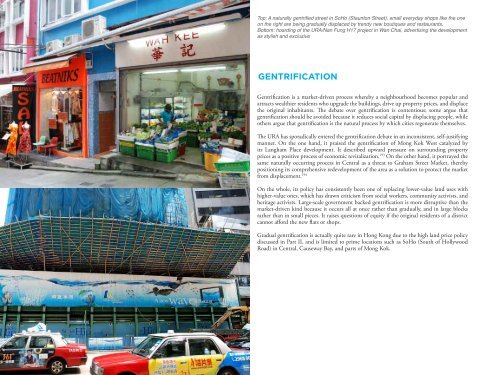Treating the Symptoms - A Critical Review of ... - Civic Exchange
Treating the Symptoms - A Critical Review of ... - Civic Exchange
Treating the Symptoms - A Critical Review of ... - Civic Exchange
- No tags were found...
Create successful ePaper yourself
Turn your PDF publications into a flip-book with our unique Google optimized e-Paper software.
Top: A naturally gentrified street in SoHo (Staunton Street), small everyday shops like <strong>the</strong> oneon <strong>the</strong> right are being gradually displaced by trendy new boutiques and restaurants.Bottom: hoarding <strong>of</strong> <strong>the</strong> URA/Nan Fung H17 project in Wan Chai, advertising <strong>the</strong> developmentas stylish and exclusiveGentrificationGentrification is a market-driven process whereby a neighbourhood becomes popular andattracts wealthier residents who upgrade <strong>the</strong> buildings, drive up property prices, and displace<strong>the</strong> original inhabitants. The debate over gentrification is contentious; some argue thatgentrification should be avoided because it reduces social capital by displacing people, whileo<strong>the</strong>rs argue that gentrification is <strong>the</strong> natural process by which cities regenerate <strong>the</strong>mselves.100The URA has sporadically entered <strong>the</strong> gentrification debate in an inconsistent, self-justifyingmanner. On <strong>the</strong> one hand, it praised <strong>the</strong> gentrification <strong>of</strong> Mong Kok West catalyzed byits Langham Place development. It described upward pressure on surrounding propertyprices as a positive process <strong>of</strong> economic revitalization. 193 On <strong>the</strong> o<strong>the</strong>r hand, it portrayed <strong>the</strong>same naturally occurring process in Central as a threat to Graham Street Market, <strong>the</strong>rebypositioning its comprehensive redevelopment <strong>of</strong> <strong>the</strong> area as a solution to protect <strong>the</strong> marketfrom displacement. 194On <strong>the</strong> whole, its policy has consistently been one <strong>of</strong> replacing lower-value land uses withhigher-value ones, which has drawn criticism from social workers, community activists, andheritage activists. Large-scale government backed gentrification is more disruptive than <strong>the</strong>market-driven kind because it occurs all at once ra<strong>the</strong>r than gradually, and in large blocksra<strong>the</strong>r than in small pieces. It raises questions <strong>of</strong> equity if <strong>the</strong> original residents <strong>of</strong> a districtcannot afford <strong>the</strong> new flats or shops.Gradual gentrification is actually quite rare in Hong Kong due to <strong>the</strong> high land price policydiscussed in Part II, and is limited to prime locations such as SoHo (South <strong>of</strong> HollywoodRoad) in Central, Causeway Bay, and parts <strong>of</strong> Mong Kok.
















